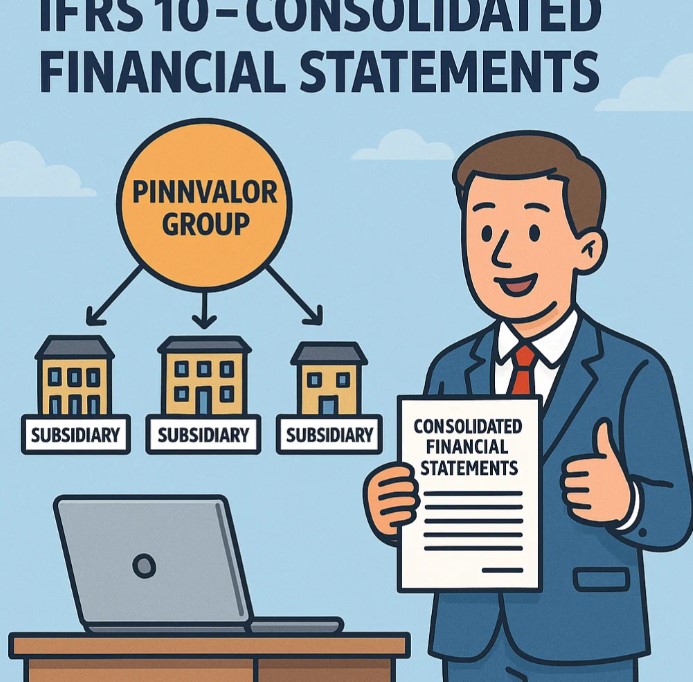
IFRS 10 – Consolidated Financial Statements: A Comprehensive Overview
In today’s interconnected corporate landscape, group structures involving parent and subsidiary relationships are increasingly common. To provide a true and fair view of the financial position and performance of such groups, IFRS 10 – Consolidated Financial Statements lays down a single, principle-based approach to consolidation. This standard redefines the concept of control and establishes uniform requirements for preparing consolidated financial statements.
What truly defines control in a corporate group — voting rights or the power to drive returns?
Consolidated financial statements under IFRS 10 reflect the economic reality, eliminating intra-group transactions and highlighting the interests of both the parent and non-controlling shareholders.
🔹 Objective of IFRS 10
IFRS 10 aims to:
- Define the principle of control as the basis for consolidation.
- Set out how to apply the control principle to identify whether an investor controls an investee.
- Provide guidance on the preparation of consolidated financial statements when control exists.
🔍 Understanding Control under IFRS 10
Control is the cornerstone of consolidation under IFRS 10. An investor controls an investee when it meets all three of the following criteria:
- Power over the investee: The investor has existing rights that give it the current ability to direct the relevant activities (i.e., the activities that significantly affect the investee’s returns).
- Exposure to variable returns: The investor is exposed, or has rights, to variable returns from its involvement with the investee.
- Ability to use power to influence returns: The investor can use its power to affect the amount of returns it receives from the investee.
This three-pronged test ensures that control is not solely based on shareholding but also includes de facto control and power via contractual arrangements.
👥 Non-Controlling Interest (NCI)
Non-controlling interest refers to the equity in a subsidiary not attributable, directly or indirectly, to the parent. IFRS 10 requires:
- Presentation of NCI in the consolidated statement of financial position within equity, separately from the parent shareholders’ equity.
- Attribution of profit or loss and each component of other comprehensive income (OCI) to the owners of the parent and to the NCI, even if this results in the NCI having a deficit balance.
At the date of acquisition, IFRS 10 provides two options for measuring NCI:
- Fair value method (full goodwill approach)
- Proportionate share method (partial goodwill approach)
🔁 Elimination of Intra-group Transactions
To reflect the group as a single economic entity, IFRS 10 mandates the elimination of:
- Intra-group assets and liabilities
- Intra-group income and expenses
- Unrealised profits and losses arising from intra-group transactions
Such eliminations ensure that only the external results of operations are reported in the consolidated financial statements.
🧩 Special Considerations: Potential Voting Rights and Structured Entities
Potential Voting Rights
IFRS 10 requires an entity to consider potential voting rights that are currently exercisable or convertible in assessing control. For example, stock options or convertible debt instruments can provide control if they are substantive.
Structured Entities
Structured entities are designed so that voting rights are not the dominant factor in deciding who controls the entity. IFRS 10 requires an investor to consider:
- The purpose and design of the entity
- The risks the entity was designed to create and pass on
- Who benefits from the returns of the entity and has the power to influence them

📄 Presentation and Disclosure Requirements
IFRS 10 requires detailed disclosures to enable users to understand:
- The composition of the group
- The interests the parent holds in subsidiaries
- Any restrictions on the ability of subsidiaries to transfer funds to the parent
- The nature and extent of significant judgments made in applying the control concept
🆚 IFRS 10 vs. Previous GAAPs
Compared to earlier consolidation standards, IFRS 10 introduced a unified definition of control and consistent treatment of subsidiaries, replacing the previously inconsistent approaches across standards such as IAS 27, SIC-12, and others.
📌 Key Takeaways
- Control is the only basis for consolidation under IFRS 10.
- Both power and variable returns must be assessed together.
- Entities must consolidate subsidiaries even when they hold less than 50% voting rights if they still exercise control.
- Full transparency in group structure and inter-company arrangements is required through robust disclosures.
📘 Conclusion
IFRS 10 revolutionized the way companies assess and report group relationships. By focusing on control as a principle rather than a rule, it ensures financial statements faithfully reflect economic reality. Whether you're a finance professional, investor, or analyst, understanding IFRS 10 is key to interpreting consolidated financial reports accurately.
